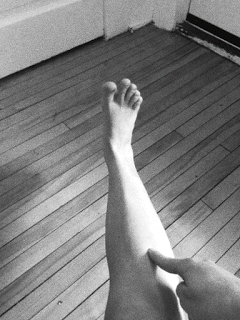Tibialis Anterior
Shin Splints!!!
If there is a tibialis posterior, then there must be a tibialis anterior, right??? Yessir, there is definitely an anterior tibialis muscle and chances are you know about it. This is because you've probably had "shin splints" from running or at least heard of them, but we'll get to that later.
ANATOMY
First the anatomy of a shin splint. The tibialis anterior muscle, not surprisingly originates from the proximal tibia bone (that shin bone you can tap with your finger), and you can definitely feel the belly of the muscle contracting when you pull your foot up, called dorsiflexion. The insertion site is at the proximal foot along the base of the first metatarsal bone and one of the small foot bones called the cuniform. While there is just one small insertion site at the end of a long tendon, the origin on the proximal tibia is attached to about 2/3 of the top part of the bone and in-between the tibia and fibula along the interosseous membrane. This origin might explain some of the symptoms of shin splints discussed below.
FUNCTION
Now that we know the origin and insertion it is pretty clear to see that when the muscle contracts it will dorsiflex the ankle (think toes to nose), bringing the attachment points on the top of the foot and front of the shin closer together. Why is this important? Well, it's probably obvious that the tibialis anterior will help direct a soccer ball when you kick it, but it's a typical, more mundane, day-to-day activity that includes keeping your toes from dragging on the ground every time you take a step. With each step, as we push off with plantar flexion at the ankle, the foot needs to get ready for that next heel strike and push-off by dorsiflexing through the leg swing. It also makes it easier to swing the leg over the ground by keeping the toe from scraping the ground when walking. In fact, those people who cannot dorsiflex at the ankle (called "foot drop"), usually wear braces to keep the ankle at 90 degrees so it is easier to walk.
DYSFUNCTION
This usually comes in the form of muscular fatigue or inflammation labeled "shin splints." I suppose it feels like the tibia is "splintering" every time your anterior tibialis pulls on it to dorsiflex the foot when running or walking. Typically this is an overuse-type injury that often plagues these small muscles that have little mass but important jobs. The important job the tibialis anterior has is getting that foot ready for a heel strike on your next stride. Since you do this a few thousand times a day, you can imagine a little problem becoming a big problem over time.
One of the little problems could be weakness of the tibialis anterior and the other muscles that dorsiflex the foot at the ankle. All that repeated contraction could lead to lactic acid production that could cause pain halfway through a run. There also could be an inflammatory process where the muscle pulls on the insertion of the tibia and interosseous membrane. Like tendonitis, repeated stress on this tissue could lead to inflammation and this tends to hurt in the morning or at the beginning of a run.
Both of these problems can be treated by gradually strengthening the muscle (might need to back off a bit to get the inflammation down), but one problem that might be overlooked would be the tightness of the calf muscles. The foot dorsiflexors might have increased work because the calf muscles and Achilles are too tight and constantly pulling the foot down. The poor tibialis anterior might be trying to overcome not just gravity but the plantarflexors pulling the foot down.
Finally, the problem of over-stressing the anterior tibialis and other dorsiflexors might be related to your running form. Running with a heel-strike first is a common technique. In fact, running with a heel-strike only possible because of the big padding we put on feet called "shoes." We walk perfectly fine with the heel hitting the floor first, and then we roll onto our forefoot to take a step. When applied to running, however, the forces are much greater, and the heel-strike actually works like a brake to slow you down. Furthermore, you gotta pull those toes out of the way to get the heel down. This is where you, or I, might be overloading the tibialis anterior every single stride, pulling that foot up so that it can hit the heel first. Thankfully, I'm a mid-foot striker ; )



